
A tale of two curricula: Euler's algebra text book
"It was the best of times, it was the worst of times, it was the age of wisdom, it was the age of foolishness, it was the epoch of belief, it was the epoch of incredulity, it was the season of Light, it was the season of Darkness, it was the spring of hope, it was the winter of despair, we had everything before us, we had nothing before us, we were all going direct to Heaven, we were all going direct the other way — in short, the period was so far like the present period, that some of its noisiest authorities insisted on its being received, for good or for evil, in the superlative degree of comparison only."
Leonhard Euler
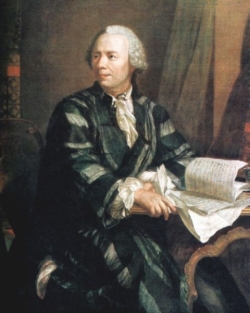
Leonhard Euler, 1707-1783. Portrait by Johann Georg Brucker.
So opens Charles Dickens's book A Tale of Two Cities, a story set in revolutionary France of 1775. This article is about a mathematician who in 1775, while France was mired in revolution, was in St Petersburg researching both mathematics and science. In particular it is about one of his books, Elements of Algebra [4 - read a review in this issue of Plus]. This mathematician was Leonhard Euler and his book is an elementary algebra textbook which starts with a discussion of the nature of numbers, of the symbols such as + and -, and then explains techniques for solving equations of various kinds. It might seem strange to consider an algebra textbook which is almost 250 years old, but there are a number of good reasons to do so.
Leonhard Euler (1707-1783) was one of the most prolific mathematical authors of all time and the 15th April 2007 was his three hundredth birthday.
In 1907 the Euler Committee of the Swiss Academy of Sciences was founded to publish all of Euler's scientific books, papers and correspondence in one edition. This vast collected work, known as Opera Omnia, now contains over 75 volumes. You can get an idea of the range of Euler's work by looking at the list compiled by the Swedish mathematician Gustav Eneström. Each item in his list of 866 distinct works was given a number, E1-E866, and these numbers are a widely accepted way to refer to specific books, papers or important scientific letters. This list of works is available online at the Euler archive. Unfortunately many of these books and scientific papers are either not available in English, are about rather obscure mathematical topics, or are simply difficult to obtain. Two exceptions to this are the recent translations by J. D. Blanton of Introduction to Analysis of the Infinite and Foundations of Differential Calculus, see [1], [2] and [3]. Although, even here, some advanced mathematics is needed as background to really appreciate their significance. On the other hand, almost anyone could read, appreciate and enjoy Elements of Algebra. Both from a historical and mathematical point of view it is important to read original sources, even if in translation.
But why Euler? Anniversaries are useful reminders, but more importantly Euler is unusual in the clarity of his mathematical writing. Laplace is quoted as saying "Read Euler, read Euler! He is the master of us all!" while Gauss apparently thought that "The study of Euler's works remains the best instruction in the various areas of mathematics and can be replaced by no other."
The translation and publication of Elements of Algebra
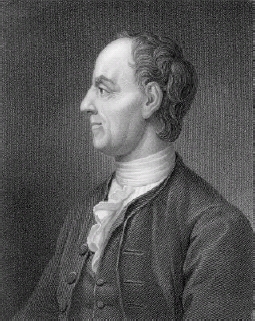
Euler again.
Euler wrote Elements towards the end of his career, when he was blind. The German editor claims that he dictated the book to a young servant, and through this taught him some mathematics, in this way educating a new amanuensis.
The Elements appears in Gustav Eneström's list of Euler's works as volumes E387 and E388, and it has a complex bibliographic history. Euler's original was written about 1765 in German. However, the first published edition, by the Royal Academy of Sciences in St Petersburg, appeared in 1770 as a Russian translation. A German edition followed swiftly, as did further translations into other European languages. The German edition was translated into French by Johann III Bernoulli. At this stage approximately one hundred pages of additions were added by Joseph Louis Lagrange (written in the 1822 book as La Grange). Francis Horner took this French edition and the English translation began as a student project. He died before it was completed and it was left to John Hewlett to complete the translation and editing and as a result the English translation is attributed to him.
How Euler structured elementary algebra
To write a commentary on Euler's work is difficult mainly because the clarity of his writing is difficult to match. Really the best advice is that of Laplace: "Read Euler!". However, to try to justify why you as a modern reader might consider making this effort, I would like to highlight two differences from the way we shape the modern curriculum which are striking, interesting and deserve comment. Rather than paraphrase Euler, these differences will be illustrated by generously quoting from Euler himself.
I have retained the paragraph numbering which is a characteristic feature of publishing at that time. The style of the language takes a little getting used to, but the effort is worthwhile. By taking this approach I hope to convince you that reading original mathematical sources is not so difficult after all.
Irrational and complex numbers
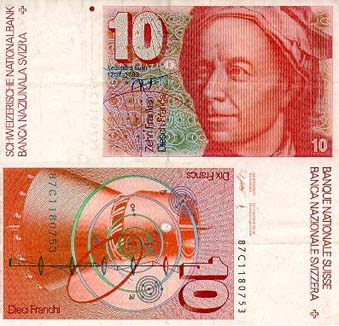
A Swiss banknote honouring Euler.
The first striking feature is the way Euler introduces both irrational and complex numbers. His attitude seems to have been to introduce them early and use them often. He begins by a thorough discussion of addition, subtraction, multiplication and division of whole numbers. In particular, for example, explaining why the product of two negative numbers is positive. Once division is introduced, it is natural to consider fractions, adding, multiplying and simplifying. After only 30 pages or so he is ready to consider square numbers and also square roots. It is here that the first mathematical difficulties are encountered.
| §125. But when the given number is not a square, as 12, for example, it is not possible to extract its square root; or to find a number, which, multiplied by itself, will give the product 12. We know, however, that the square root of 12 must be greater than 3, because 3 × 3 produces only 9, and less than 4, because 4 × 4 produces 16, which is more that 12; we know also, that this root is less than $3\frac{1}{2}$, for we have seen that the square of $3\frac{1}{2}$, or $\frac{7} {2}$, is $12\frac{1}{4};$ and we may approach still nearer to this root, by comparing it with $3\frac{7}{15}$; for the square of $3\frac{7}{15}$, or of $\frac{52}{15}$, is $\frac{2704}{225}$, or $12\frac{4}{225};$ so that this fraction is still greater than the root required, though by very little so, as the difference of the two squares is only $\frac{4}{225}. |
| §126. We may suppose that as $ 3\frac{1}{2}$ and $3\frac{7}{15} $ are numbers greater than the root of 12, it might be possible to add to 3 a fraction a little less than $\frac{7}{15}$, and precisely such, that the square of the sum would be equal to 12. |
After a neat paragraph in which Euler approximates the square root of 12 by squaring three further fractions, but fails to obtain the integer 12 exactly, he concludes:
| §127. It is evident, therefore, that whatever fraction is joined to 3, the square of that sum must always contain a fraction, and can never be exactly equal to the integer 12. [ ... ] But notwithstanding this, we are not to assert that the square root of 12 is absolutely and in itself indeterminate: it only follows from what has been said, that this root, though it necessarily has a determinate magnitude, cannot be expressed by fractions. |
| §128. There is therefore a sort of number which cannot be assigned by fractions, but which are nevertheless determinate quantities; as, for instance, the square root of 12: and we call this new species of numbers, irrational numbers. They occur whenever we endeavour to find the square root of a number which is not a square; thus, 2 not being a perfect square, the square root of 2, or the number which, multiplied by itself, would produce 2, is an irrational quantity. These numbers are also called surd quantities, or incommensurables. |
 One of the most famous irrational numbers is the golden ratio, intimately connected to shapes occurring in nature and art. Read The golden ratio and aesthetics to find out more. |
|
§129. These irrational quantities, though they cannot be expressed by fractions, are nevertheless magnitudes of which we may form an accurate idea; since, however concealed the square root of 12, for example, may appear, we are not ignorant that it must be a number, which, when multiplied by itself, would exactly produce 12; and this property is sufficient to give us an idea of the number, because it is in our power to approximate towards its value continually. |
In the next section Euler addresses a particularly difficult problem: how to take the square root of a negative number.
|
§139. We have already seen that the squares of numbers, negative as well as positive, are always positive, or affected by the sign +; having shown that -a multiplied by -a gives +aa, the same as the product of +a by +a: wherefore, in the preceding section, we supposed that all the numbers, of which it was required to extract the square roots, were positive. §140. When it is required, therefore, to extract the root of a negative number, a great difficulty arises; since there is no assignable number, the square of which would be a negative quantity. Suppose, for example, that we wished to extract the root of -4; we here require such a number as, when multiplied by itself, would produce -4: now, this number is neither +2 nor -2, because the square of both of +2 and of -2, is +4, and not -4. |
|
§141. We must therefore conclude, the square root of a negative number cannot be either a positive number or a negative number, since the square of negative numbers also take the sign plus; consequently, the root in question must belong to an entirely distinct species of numbers; since it cannot be ranked either among positive or among negative numbers. §142. Now, we before remarked, that positive numbers are all greater than nothing, or 0, and that negative numbers are all less than nothing, or 0, so that whatever exceeds 0 is expressed by positive numbers, and whatever is less than 0 is expressed by negative numbers. The square roots of negative numbers, therefore, are neither greater nor less than nothing; yet we cannot say, that they are 0; for 0 multiplied by 0 produces 0, and consequently does not give a negative number. |
 Complex numbers may have seemed absurd at first, but they soon proved their usefulness. Read Maths goes to the movies to find out how they are used in computer-generated movies and games, like Neverwinter Nights depicted here. |
|
§143. And, since all numbers which it is possible to conceive, are either greater or less than 0, or are 0 itself, it is evident that we cannot rank the square root of a negative number amongst possible numbers, and we must therefore say that it is an impossible quantity. In this manner we are led to the idea of numbers, which from their nature are impossible; and therefore they are usually called imaginary quantities because they exist merely in the imagination. §144. All such expressions,as $\sqrt{-1}$, $\sqrt{-2}$, $\sqrt{-3}$, $\sqrt{-4}$, $\&c$. are consequently impossible, or imaginary numbers, since they represent roots of negative quantities; and of such numbers we may truly assert that they are neither nothing, nor greater than nothing, nor less than nothing; which necessarily constitutes them imaginary, or impossible. |
| §145. But notwithstanding this, these numbers present themselves to the mind; they exists in our imagination, and we still have a sufficient idea of them; since we know that by $\sqrt{-4}$ is meant a number which, multiplied by itself, produces $-4$; for this reason also, nothing prevents us from making use of these imaginary numbers and employing them in calculation. |
| §146. The first idea that occurs on the present subject is, that the square of $\sqrt{-3}$, for example, or the product of $\sqrt{-3}$ by $\sqrt{-3}$, must be $-3$; that the product of $\sqrt{-1}$ by $\sqrt{-1}$, is $-1$; and, in general, that by multiplying $\sqrt{-a}$ by $\sqrt{-a}$, or by taking the square of $\sqrt{-a}$ we obtain $-a$. |
| §147. Now, as $-a$ is equal to $+a$ multiplied by $-1$, and as the square root of a product is found by multiplying together the roots of its factors, it follows that the root of $a$ times $-1$, or $\sqrt{-a}$, is equal to $\sqrt{a}$ multiplied by $\sqrt{-1}$; but $\sqrt{a}$ is a possible or real number, consequently the whole impossibility of an imaginary quantity may be always reduced to $\sqrt{-1}$; for this reason $\sqrt{-4}$ is equal to $\sqrt{4}$ multiplied by $\sqrt{-1}$, or equal to $2\sqrt{-1}$, because $\sqrt{4}$ is equal to 2; likewise $-9$ is reduced to $\sqrt{9} \times \sqrt{-1}$, or $3\sqrt{-1}$; and $\sqrt{-16}$ is equal to $4\sqrt{-1}$. |
All this seems to be thoroughly convincing, but we should beware! Euler is about to make a very rare and uncharacteristic mistake.
|
§148. Moreover, as $\sqrt{a}$ multiplied by $\sqrt{b}$ makes $\sqrt{ab}$ we shall have $\sqrt{6}$ for the value of $\sqrt{-2}$ multiplied by $\sqrt{-3}$; and $\sqrt{4}$ or $2$, for the value of the product of $\sqrt{-1}$ and $\sqrt{-4}.$ Thus we see that two imaginary numbers, multiplied together, produce a real, or possible one. But, on the contrary, a possible number, multiplied by an impossible number, gives always an imaginary product: thus $\sqrt{-3}$ by $\sqrt{+5}$, gives $\sqrt{-15}$. §149. It is the same with regard to division; for $\sqrt{a}$ divided by $\sqrt{b}$ making $\sqrt{\frac{a}{b}}$, it is evident that $\sqrt{-4}$ divided by $\sqrt{-1}$ will make $\sqrt{+4}$ or $2$; that $\sqrt{+3}$ divided by $\sqrt{-3}$ will give $\sqrt{-1}$; and that $1$ divided by $\sqrt{-1}$ gives $\sqrt{\frac{+1}{-1}}$, or $\sqrt{-1}$; because $1$ is equal to $\sqrt{+1}.$ |
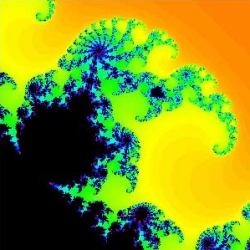 More than 200 years after Euler mathematicians found that complex numbers give rise to the most amazing fractals. Read Plus article Unveiling the Mandelbrot set to find out more. |
According to modern usage, we define the symbol $i$ to have the property that $i \times i = i^2 = -1$. A shorthand for this is that $i := \sqrt{-1}$. Using $i$ we can be a lot more careful with the way the minus sign is manipulated underneath the square root signs. For §148 the calculation then reads $$ \sqrt{-2} \times \sqrt{-3} = i\sqrt{2} \times i\sqrt{3} = i^2\sqrt{6} = -\sqrt{6}, $$ not $\sqrt{6}$ as Euler has it. Similarly for §149 this gives us the result $$ \frac{1}{i} = \frac{1}{i}\frac{i}{i} = \frac{i}{i \times i} = -i.$$ Recall that Euler here gives $\frac{1}{\sqrt{-1}} = \sqrt{-1}$.
Nevertheless, the view that Euler expresses in the next paragraph has certainly been vindicated by subsequent history.
| §151. It remains for us to remove any doubt, which may be entertained concerning the utility for the numbers of which we have been speaking; for those numbers being impossible, it would not be surprising if they were thought entirely useless, and the object only of an unfounded speculation. This, however, would be a mistake; for the calculation of imaginary quantities is of the greatest importance, as questions frequently arise, of which we cannot immediately say whether they include any things real and possible, or not; but when the solution of such a question leads to imaginary numbers, we are certain that what is required is impossible. |
It is striking to a modern reader that Euler has introduced imaginary numbers after only 40 pages of a 300 page book before any real symbolic algebra. Introducing them at this point naturally explains the difficulty of taking the square root of a negative number and as we shall see in a moment helps us to solve quadratic equations completely. We might well ask: why then are imaginary numbers not even part of the A-level mathematics core curriculum?
Solving equations
After this opening Euler continues in a systematic way to consider cubes of numbers, cube roots, powers in general, and roots in general. Chapter 2 begins algebra by considering "compound quantities" such as a + b and operations involving these. As before, the systematic treatment includes addition, subtraction, multiplication and division. Squaring, general powers and taking roots is considered. These roots and powers include fractional powers, so that
$ \sqrt{a+b} = (a+b)^\frac{1}{2}$
is discussed and infinite series are used to express these in a different form.
Chapter 3 contains number patterns, including triangular numbers, geometric progressions and similar work. It is not until chapter 4 that algebraic equations and the solution of these equations are considered.
| §563. The principal object of Algebra, as well as of all the other branches of Mathematics, is to determine the value of quantities that were before unknown; and this is obtained by considering attentively the conditions given, which are always expressed in known numbers. For this reason, Algebra has been defined, The science which teaches how to determine quantities by means of those that are known. |
Euler starts with a single unknown quantity $x$ and a single equation which must be solved in order to obtain the solution. These he classifies into various types, based on the highest power of $x$ present in the equation. His aim is to provide a method of solution for each type of equation, starting with linear equations, for example $2x-1 = 3.$
Solving a quadratic
| §638. An equation of the second degree is said to be mixt, or complete, when three terms are found in it, namely, that which contains the square of the unknown quantity, as $ax^2$; that, in which the unknown quantity is found only in the first power, as $bx$; and, lastly, the term which is composed of only known quantities. And since we may unite two or more terms of the same kind into
one, and bring all the terms to one side of the sign =, the general form of a mixt equation of the second degree will be $$ ax^2\pm{bx} \pm{c} = 0. $$ In this section, we shall show how the value of $x$ may be derived from such equations: and it will be seen, that there are two methods of obtaining it. |
 The motion of the planets can be described by a quadratic equation. Read 101 uses of a quadratic equation: Part II to find out more. Image courtesy NASA. |
| §639.An equation of the kind that we are now considering may be reduced, by division, to such a form, that the first term may contain only the square, $x^2$, of the unknown quantity $x$. We shall leave the second term on the same side with $x$, and transpose the known term to the other side of the sign =. By these means our equation will assume the form of $x^2 \pm{px} = \pm{q}$, in which $p$ and $q$ represent any known numbers, positive or negative; and the whole is at present reduced to determining the true value of $x$. We shall begin by remarking, that if $x^2 + px$ were a real square, the resolution would be attended with no difficulty, because it would only be required to take the square root of both sides. |
| §640. But it is evident that $x^2 + px$ cannot be a square; since we have already seen, §307, that if a root consists of two terms, for example, $x + n$, its square always contains three terms, namely, twice the product of the two parts, besides the square of each part; that is to say, the square of $x+n$ is $x^2 + 2nx + n^2$. Now, we have already on one side $x^2 + px$; we may, therefore, consider $x^2$ as the square of the first part of the root, and in this case $px$ must represent twice the product of $x$, the first part of the root, by the second part: consequently, this second part must be $\frac{1}{2}p$, and in fact the square of $x + \frac{1}{2}p$, is found to be $$ x^2 + px + \frac{1}{4} p^2.$$ |
| §641. Now, $x^2 + px + \frac{1}{4}p^2$ being a real square, which has for its root $x + \frac{1}{2}p$, if we resume our equation $x^2 + px = q$, we have only to add $\frac{1}{4}p^2$ to both sides, which gives us $$ x^2 + px + \frac{1}{4}p^2 = q + \frac{1}{4}p^2,$$ the first side being actually a square, and the other containing known quantities. If, therefore, we take the square root of both sides, we find $$x+\frac{1}{2}p = \sqrt{\frac{1}{4}p^2 + q};$$ subtracting $\frac{1}{2}p$, we obtain $$ x = -\frac{1}{2}p+\sqrt{\frac{1}{4}p^2 + q;$$ and, as every square root may be taken either affirmatively or negatively, we shall have for $x$ two values expressed thus; $$x = -\frac{1}{2}p\pm{\sqrt{\frac{1}{4}p^2 + q;}.$$ |
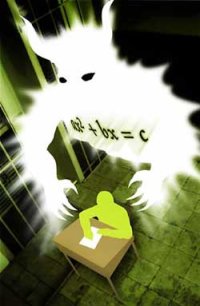 No need to fear equations if you read Euler. |
| §642. This formula contains the rule by which all quadratic equations may be resolved; and it will be proper to commit it to memory, that it may not be necessary, every time, to repeat the whole operation which we have gone through. We may always arrange the equation in such a manner, that the pure square $x^2$ may be found on one side, and the above equation has the form $x^2 = -px + q$, where we see immediately that $$ x = -\frac{1}{2}p \pm{\sqrt{\frac{1}{4}p^2 + q}}. |
Euler then goes on to exhibit the second method for solving a quadratic using a change of variable which removes one of the terms.
What is conspicuous is the total absence of the factorisation of quadratics by inspection. Indeed factorisation of quadratics is only discussed later in §689 since
| Equations of the second degree admit of two solutions; and this property ought to be examined in every point of view, because the nature of equations of a higher degree will be very much illustrated by such an examination. |
This detailed discussion includes the cases when the root is repeated, and when two imaginary roots result in a quadratic with real coefficients. Then follows the solution of cubic equations, using Cardan's technique, and solutions of 4th degree polynomials. Interestingly, in §780, Euler discusses the lack of formulae for the solution of higher degree polynomial equations. He gives no sense that such a solution may be impossible (as we now know), commenting only that "This is the greatest length to which we have yet arrived in the resolution of algebraic equations".
Conclusion
It is only by stepping outside the educational system in which we find ourselves immersed that we can question and evaluate why certain choices have been made. One way to do this is to look internationally, another is historically. Euler's Elements of Algebra is an interesting read in its own right and an excellent and relevant mathematics text book. Furthermore, the choices he makes are sometimes surprising and allow us to question what we do now. His style is unhurried and yet hardly ever seems long-winded.
At the end of Part I of his book Euler gives the reader a hint of the style which his more advanced works, [1], [2], [3] adopt.
| §799. We may even apply this method to equations which go on to infinity. The following will furnish an example: $$ x^\infty = x^{\infty-1} + x^{\infty-2} + x^{\infty-3} + x^{\infty-4} +,\&c.$$ [...] If we divide the equation by $x^\infty$, we shall have $$1 = \frac{1}{x} + \frac{1}{x^2} + \frac{1}{x^3} + \frac{1}{x^4} +,\&c.$$ a geometrical progression, whose sum is found $= \frac{1}{x-1}$; so that $1 = \frac{1}{x-1}$; multiplying therefore by $x-1$, we have $x-1 = 1$, and $x = 2$. |
If you want to understand exactly what he means by this you will have to read the original.
References
[1] L. Euler. Introduction to Analysis of the Infinite, volume I. Springer, 1988. Translated by Blanton, J. from the Latin Introductio in Analysin Infinitorum, 1748.
[2] L. Euler. Introduction to Analysis of the Infinite, volume II. Springer, 1990. Translated by Blanton, J. from the Latin Introductio in Analysin Infinitorum, 1748.
[3] L. Euler. Foundations of Differential Calculus. Springer, 2000. Translated by Blanton, J. from the Latin Institutiones Calculi Differentialis, 1755.
[4] L. Euler. Elements of Algebra. Tarquin Publications, 2006.
[5] A. Heefer. The Origin of the Problems in Euler's Algebra. (unpublished), 2005.
About the author

Chris Sangwin is a member of staff in the School of Mathematics at the University of Birmingham. He has recently edited a version of Euler's Elements of Algebra, see the review in this issue of Plus. He has also written the popular mathematics books Mathematics Galore!, with Chris Budd, and How round is your circle? with John Bryant.
Euler's Elements of Algebra, edited by Chris Sangwin, is reviewed in this issue of Plus.
Comments
Anonymous
Last year I came down with a cold and found myself browsing through google books. I stumbled over Euler's Elements and was immediately hooked. After reading 100 pages or so in one afternoon I decided to try teach my kids (8 and 10 year old) using Euler's book as their textbook. And so every Saturday morning we would assemble around the kitchen table and go through a couple of paragraphs of Euler's work. Suffice it to say the kids were amazed by what they learned and how (relatively) easy it was for them to follow. Indeed, Euler's clarity of explaining the subject matter is unrivaled - wish the schools would use it. Learning from the masters of a subject, especially when they are gifted to explaining the complicated in clear and lucid terms is a wonderful experience (and reminds me of Hans Oerberg's Lingua Latina).
Fun anecdote: When one of my boys explained to a neighbor kid what imaginary numbers are and how they come about his friend got irritated and said "you are not supposed to know that, you don't even have pi memorized yet"...
Thanks for this great article!